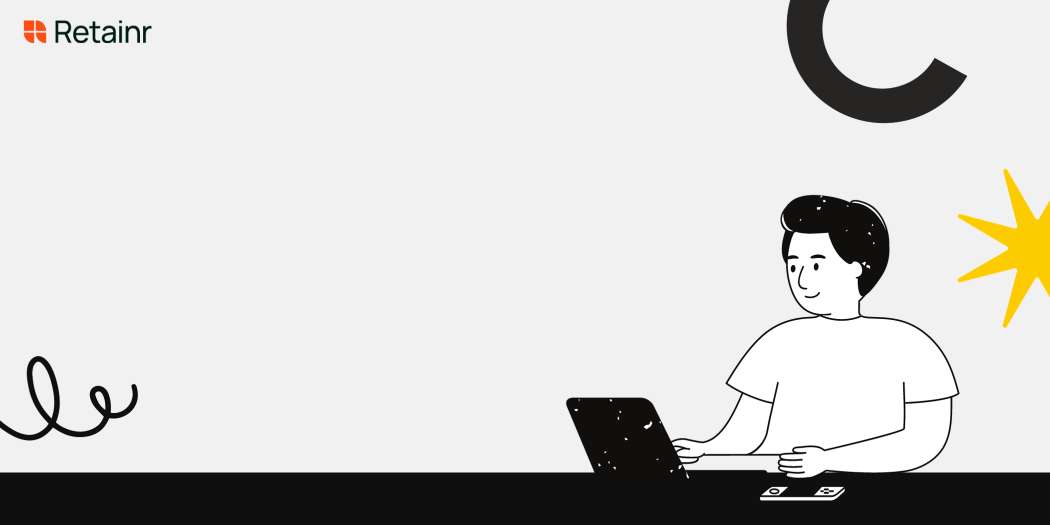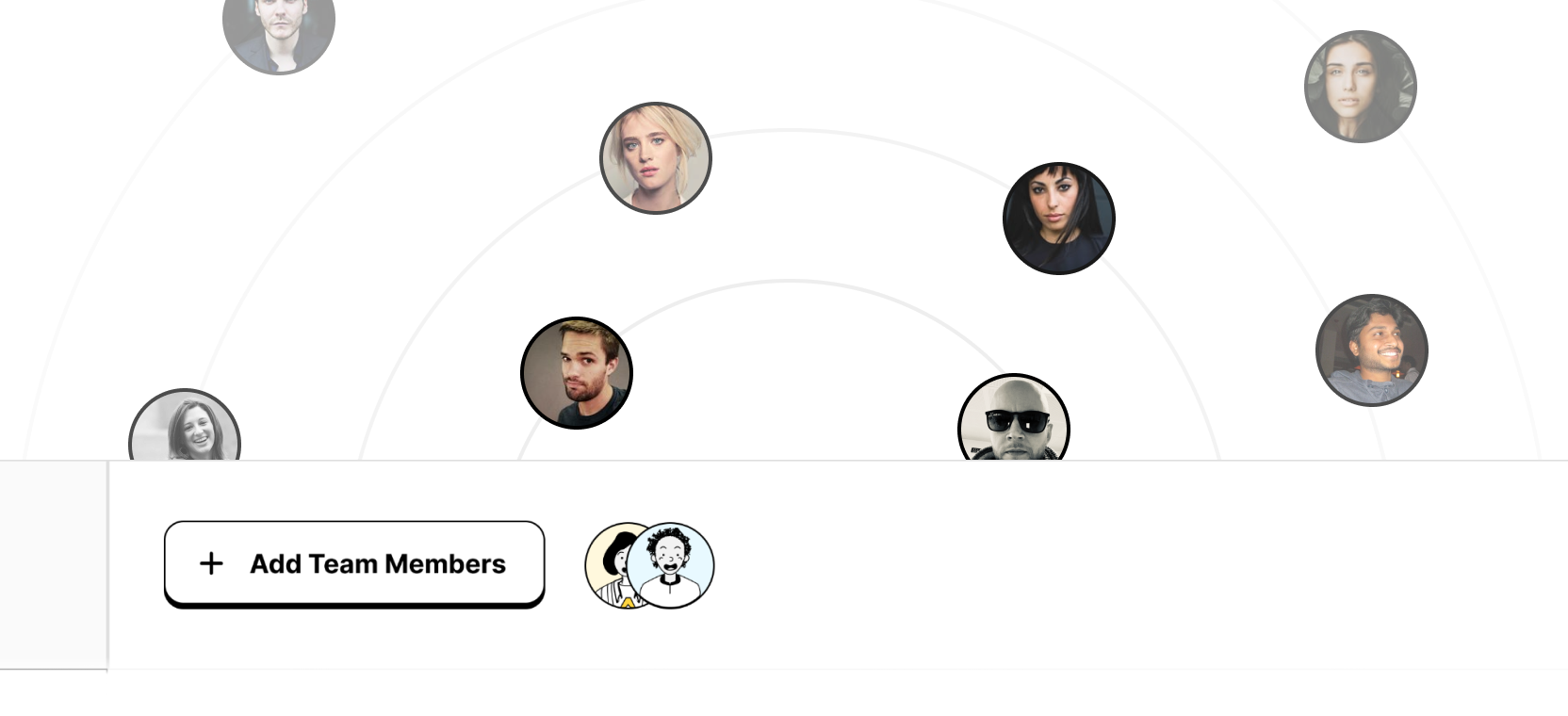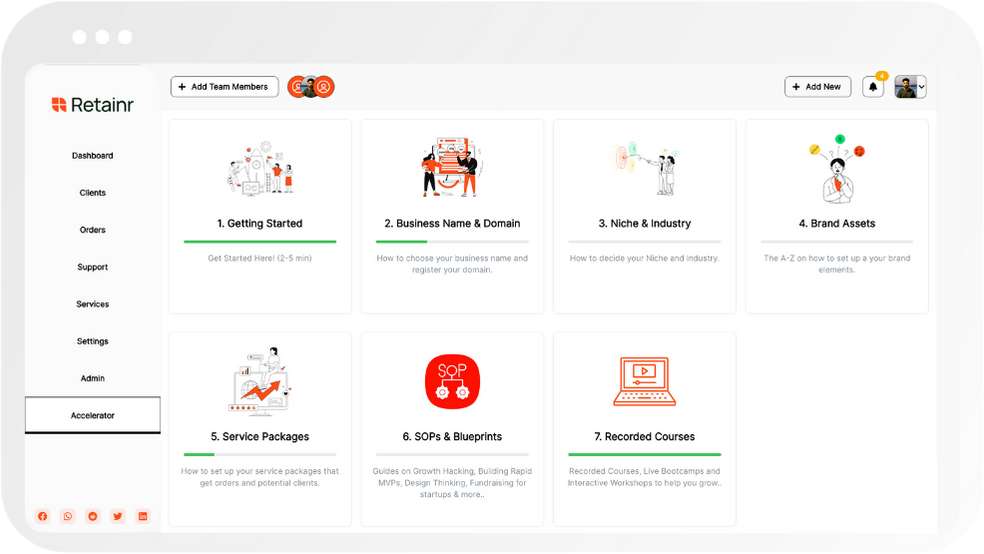
7 Essential Ways Freelancers Can Improve Client Communication
Build with Retainr
Sell your products and services, manage clients, orders, payments, automate your client onboarding and management with your own branded web application.
Get Started1. What are the seven essential ways freelancers can improve client communication?
Clear and Constructive Communication
Freelancers must ensure that their communication style is clear and constructive. Confusing or ambiguous messages could lead to misunderstandings and errors, which might ultimately harm the client relationship. In order to enhance clarity, freelancers can:
- Use simple and direct language
- Avoid technical jargon unless the client is familiar with it
- Clarify points in writing to avoid miscommunication
Timely and Responsive Interaction
It is important for freelancers to always be prompt when communicating with clients. Keeping the client waiting might signal disinterest or unprofessionalism. Clients appreciate timely responses to their queries or requests. As a freelancer, you should:
- Respond promptly to client's emails or messages
- Update them regularly on the progress of the project
Understanding and Catering to Client's Preferences
Clients will likely have preferred channels for communication, as well as particular styles. Understanding these preferences and adapting to them is a crucial step towards improving communication. As an effective communicator, a freelancer needs to:
| Action | Explanation |
|---|---|
| Know your client's preferred communication platform | Different clients may prefer different platforms like email, phone calls, or messaging apps. It's important to adapt to your client's choice for smoother communication. |
| Adjust your communication style to your client | If your client prefers a more formal style, maintain that formality in your interactions. Similarly, if your client prefers a more casual style, feel free to mirror it. |
2. Why should a freelancer focus on improving their client communication skills?
Importance of Communication Skills for Freelancers
Freelancers rely heavily on their ability to communicate effectively with their clients. Unlike employees working in an office environment, freelancers cannot walk over to their client’s desk to clarify a task. This necessitates excellent communication skills to ensure that all aspects of a project, from the brief to the final delivery, are understood and executed accurately. Essentially, strong client communication skills foster understanding, trust, and successful project completion.
The Role of Communication Skills in Generating Repeat Business
By mastering superior communication skills, freelancers increase their chances of securing repeat business, which is a key ingredient to achieving a stable income. Clients are more likely to return to a freelancer who communicates effectively and can accurately deliver on project goals. This is largely dependent on three key communication aspects:
- Clarity: Clear communication ensures that all tasks are understood and agreed upon from the outset, reducing misunderstandings and unnecessary revision cycles.
- Responsiveness: Quick response times show commitment and reliability, two attributes highly valued by clients.
- Managing Expectations: Proper communication allows freelancers to manage client expectations, ensuring that both parties are on the same page regarding project timelines and deliverables.
Boosting Reputation through Effective Communication
Lastly, freelancers who communicate effectively improve their professional reputation. Word of mouth recommendations can significantly influence a freelancer's career trajectory. A helpful table outlining the elements of good communication and their impact on a freelancer's reputation follows:
| Elements | Impact on reputation |
|---|---|
| Timely responses | Clients perceive the freelancer as reliable and professional. |
| Clear communication | Fosters trust as clients feel understood and assured that their projects are in competent hands. |
| Regular updates | Enhances the freelancer's image as transparent and dedicated, particularly if such updates include sharing milestones, achievements or challenges encountered during the project process. |
3. How can clear and frequent communication help in building a strong relationship with clients?
Clear Communication is Crucial
Clear communication is key for building trust in any relationship, especially in a professional context. By maintaining consistent and transparent communication, you can ensure that both you and your clients are on the same page about project expectations, deadlines, and progress updates. This not only eliminates unnecessary misunderstandings but also strengthens the overall relationship by fostering a sense of trust and reliability.
Key benefits of clear and frequent communication are:
- Prevents misunderstandings by ensuring that clients understand your processes and objectives.
- Fosters trust and demonstrates your commitment to the client's project.
- Helps manage the client's expectations and keeps them informed about project status.
- Allows for timely feedback and adjustments, which increases overall project efficiency.
The Role of Frequent Communication
Frequent communication is just as important as clarity. Staying in regular contact contributes to stronger relationships with clients for several reasons:
| Reason | Explanation |
|---|---|
| Keeps clients in the loop | Regular status updates help clients feel involved in the project and assures them of progress. |
| Demonstrates reliability | Consistent communication shows you're dependable, which can strengthen your professional relationship. |
| Allows faster response to issues | The sooner issues are communicated, the sooner they can be addressed— preventing delays and increasing client satisfaction. |
4. How can freelancers use technology to improve their communication with clients?
Utilizing Technology Smartly
Freelancers can effectively use technology to enhance their communication with clients in various ways. Firstly, they can utilize instant messaging and video conferencing apps, such as Skype, Zoom, or Whatsapp, to maintain continuous, real-time interaction with clients. These platforms offer features like screen sharing and recording, which can greatly aid in explaining challenging concepts or discussing project details.
- Email & Project Management tools: Email remains the most professional and widely accepted medium for official communication. Good use of email etiquette can ensure clear, concise, and timely communication. Besides, project management tools like Trello, Asana or Slack bring everyone on the same page by keeping track of project progress, assigning tasks, and ensuring smooth collaboration.
- Social Media: LinkedIn and other professional social networks are excellent platforms to share updates about ongoing projects, industry news, or insights, effectively building a personal brand and maintaining open long term communication.
Use of Technology for Fast and Effective Feedback
Technology not only improves communication but also aids in giving and receiving feedback effectively. Tools like Google Docs allow real-time commenting and editing, making the feedback process quicker and more efficient. Similarly, markup software or tools like InVision, with their ability to leave direct feedback on design elements, streamline the process of critical analysis in unique ways.
| Tool | Use |
|---|---|
| Google Docs | Real-time commenting and editing |
| InVision | Direct feedback on design elements |
Freelancers should remember to embrace technology for client communication purposefully and productively. By using the right tools, they can keep communication clear, reduce administrative tasks, and focus more on delivering excellent work.
5. Can regular feedback and updates help freelancers in enhancing client communication?
Importance of Regular Feedback and Updates
Regular feedback and updates play a crucial role in enhancing client communication. Firstly, it helps in building a strong client-freelancer relationship by promoting transparency and trust. Regular updates about work progress keep the client in the loop, making them feel involved in the process. Secondly, feedback received from clients can be immensely valuable. It provides an opportunity to understand their perspective, enabling freelancers to align their work better with client requirements. Thirdly, regular communication also provides an avenue for addressing issues and concerns in a timely manner, thereby preventing any miscommunication or misunderstandings.
The Process of Incorporating Feedback and Updates
- Establish a communication routine: Set a regular schedule for updates and feedback sessions. This could be weekly, bi-weekly, or monthly based on project specifics and client preferences.
- Implement Feedback: After receiving feedback, make sure to incorporate it effectively. Show your clients that their input is valued and has a direct impact on the project's outcome.
- Open to Suggestions: Be open and receptive to client suggestions. This not only improves the quality of work but also enhances the client's trust in your abilities.
- Use Appropriate Tools: Use suitable project management and communication tools that facilitate easy sharing of updates and collection of feedback.
Evidence Supporting Positive Impact of Communication
| Evidence | Explanation |
|---|---|
| Improved Client Satisfaction | Regular updates and prompt implementation of feedback enhances client satisfaction as they appreciate the dedication and professional approach. |
| Increase in Repeat Business | Good communication leads to strong client relationships, often increasing the likelihood of repeat business and referrals. |
| Progressive Improvement in Quality of Work | Continuous feedback serves as a tool for self-improvement, helping freelancers to grow and deliver better quality work over time. |
6. How can freelancers effectively deal with difficult or dissatisfied clients?
Identifying and Understanding Client Concerns
Effective communication is the key to dealing with dissatisfied clients. Freelancers should always make an effort to understand the root cause of the client's dissatisfaction. This can often be achieved by asking clarifying questions and displaying empathy. Once the problem is understood, a freelancer can then address the client's concerns effectively.
- Ask open-ended questions: This gives room for the client to fully express their concerns.
- Show empathy: Understanding the client's point of view and showing it helps build rapport with the client.
- Provide reassurance: Assure the client that their concerns are being taken seriously and that steps are being taken to resolve the issue.
Offering Solutions and Follow-ups
After identifying the issue, the freelancer should then offer solutions that may help alleviate the client's dissatisfaction. Prompt and effective problem-solving often leaves clients feeling satisfied even after an initial complaint. It is also important to follow up with clients to ensure they are satisfied with the solution provided. This not only shows professionalism but also builds trust.
| Client Actions | Freelancer's Response |
|---|---|
| Issues a complaint | Offer immediate solutions |
| Seems dissatisfied with the solution | Propose alternative solutions |
| No feedback after solution is offered | Follow up with the client |
Learning from Mistakes
It is not unusual for freelancers to encounter dissatisfied clients now and then. The key is to take these instances as opportunities to improve. Take note of the common complaints clients voice and plan on how to avoid such scenarios in the future. Planning for future client interactions should be part of a freelancer's growth strategy.
- Identify patterns: If several clients are voicing the same complaint, there may be a system problem that needs to be addressed.
- Create a plan: Once common issues have been identified, create a plan of action to avoid future complaints.
- Adopt a growth mindset: Always be open to constructive criticism and use it to better your work.
7. What is the role of setting clear expectations in improving freelancer-client communication?
Role of Setting Clear Expectations in Freelancer-Client Communication
The role of setting clear expectations in freelancer-client communication is pivotal and multifaceted. It essentially lays the groundwork for a successful professional relationship, smooth project execution, and timely completion.
- Understand Scope of Work: Setting clear expectations helps both parties understand the scope of the work. It prevents ambiguity and confusion thus avoiding possible misunderstandings and conflicts.
- Timelines and Deadlines: It allows both the freelancer and the client to agree on specific timelines and deadlines.
- Quality Standards: A clear understanding of the expected quality of work makes it easier for the freelancer to deliver up to the mark.
Let's take a closer look at how expectation management unfolds with communication.
| Expectation | Communication Mechanism | Outcome |
|---|---|---|
| Scope of Work | Detailed project discussion | Defined understanding of the work, its requirements and limitations |
| Timelines and Deadlines | Established deliverables timeline | In-time project completion, measurable progress |
| Quality Standards | Discussed and agreed upon quality parameters | Deliverables meeting the agreed standard |
In conclusion, setting clear expectations is not merely an administrative formality, but a crucial prerequisite for effective communication. It reduces the uncertainty, streamlines the workflow, and eventually leads to client satisfaction which is the ultimate objective for any freelancer.
8. Are there specific tools or software that can help freelancers communicate better with their clients?
Utilizing Specific Tools and Software for Better Communication
The modern technology landscape offers a wide array of tools and software that can drastically improve freelancers' communications with their clients. From project management tools to chat applications, these platforms allow freelancers to stay connected, collaborate on tasks, share files, meet deadlines, and get feedback.
Here are some exceptional tools every freelancer should consider:
- Slack: This tool provides a dynamic communication platform for teams with its integrated chat rooms. It supports file sharing, direct messaging, and voice/video calling.
- Trello: Trello is an efficient project management tool where freelancers can organize tasks into boards, making it easy to visualize workflow. Clients can see the progress in real-time, creating transparency.
- Zoom: For video conferencing, Zoom remains the top choice. It provides stable and high-quality voice/video calls where freelancers can discuss project details at length.
- Dropbox: When it comes to file sharing, Dropbox is among the best. Huge files that can't be sent via email can easily be shared through Dropbox.
- Asana: Asana is a comprehensive project management tool, allowing freelancers to track the progress of their projects and tasks.
Comparing Key Features of Top Communication Tools
| Tool | Primary Use | Key Features |
|---|---|---|
| Slack | Communication | Integrated chat rooms, file sharing, direct messaging, voice/video calls |
| Trello | Project Management | Organizing tasks into boards, visualization of workflow |
| Zoom | Video Conferencing | High-quality voice/video calls |
| Dropbox | File Sharing | Large file sharing capability |
| Asana | Project Management | Tracking progress of projects and tasks |
9. How can a freelancer showcase professionalism in their communication with clients?
Displaying Professionalism Through Emails
Email is one of the most common and essential tools of communication for freelancers with clients. To display professionalism, first, always address the client respectfully with the use of professional greetings such as "Dear", followed by their name. Secondly, maintain a clear and concise tone, avoid using jargon. Ensure your emails are well-structured with complete sentences and proper grammar usage. Lastly, make sure that your emails are free of spelling and punctuation errors. You should also use a professional email signature, containing your name, your job title, and your contact information.
Exhibiting Professionalism During Virtual Meetings
In today's digital age, virtual meetings have become the norm for most freelancers. To ensure that your meeting presents an image of your professionalism, there are several key aspects. The first is your appearance. Make sure you are appropriately dressed, and that your background is clean and distraction-free.Secondly, maintain eye contact and use non-verbal communication effectively. Thirdly, you should also be aware of your body language, and make sure it conveys seriousness and enthusiasm for your job.
| Aspect | Explanation |
|---|---|
| Appearance | Appropriately dressed, clean and distraction-free background |
| Eye Contact & Non-Verbal Communication | Maintain eye contact and use your hands to emphasise points during the discussion |
| Body Language | Ensure your body language conveys seriousness and enthusiasm |
Conveying Professionalism Through Timeliness and Responsiveness
Being timely and responsive is, without doubt, an essential characteristic of professionalism. This means responding to messages and emails within a reasonable time, and meeting the client's deadlines. To help achieve this, use a professional project management tool to keep track of deadlines and tasks. It's also important to keep communication channels open and manage client expectations about your availability: if you can't answer a client's question immediately, let them know you've seen their message and when they can expect your response.
10. How can understanding and meeting clients' needs improve client- freelancer communication?
Understanding Clients' Needs
Understanding the needs of your clients is a vital part of successful freelance-client communication. When you thoroughly understand the project's requirements, it aids in asking relevant questions, providing timely solutions, and meeting set deadlines effectively. Honing this understanding will minimize miscommunication, revisions, and provide a seamless client experience. This understanding can be honed through:
- Listening attentively during briefings and reading project descriptions thoroughly.
- Actively asking clarifying questions before and during the project where necessary.
- Being proactive in researching and understanding the client's industry, target audience, and project goals.
Meeting Client's Needs
Meeting client needs doesn't only mean delivering the job within the agreed timeline and budget but also ensuring the output meets or exceeds clients' expectations. This increases client satisfaction and the likelihood of repeat business. Here are some effective ways of meeting clients' needs:
| Method | Description |
|---|---|
| Regular updates | Provide regular project updates to keep the client in the know. This reassures them about the progress and helps manage their expectations. |
| Requesting feedback | Invite the client to give feedback at different stages of the project. This helps you adjust the direction of your work to better align with the client’s vision. |
| Predicting needs | Anticipate the client's needs based on their past behaviors, preferences, and industry standards. This proactivity can often wow a client, thereby improving your communication relationship. |
Impact on Communication
By understanding and meeting the client's needs, you cultivate trust, and your relationship becomes more of a partnership rather than a transaction. This shared understanding and mutual respect will drastically improve the communication between you and your client. Not only will your interactions be more efficient, but they will also become more enjoyable, forming a solid foundation for future collaborations.
Conclusion
Essential Ways Freelancers Can Improve Client Communication
One of the top challenges for freelancers is effectively communicating with clients. Effective communication can help develop robust relationships with clients, lead to job satisfaction, and eventually grow your freelance business. Here are seven essential ways that can help you improve communication with your clients.
1. Clear On-Boarding Process
Define a clear on-boarding process. This process should help your clients understand what to expect right from the start concerning deliverables, timelines, and communication channels.
2. Regular Updates and Reports
Provide your clients with regular updates and detailed reports about the progress of the project. This will keep your clients informed and develop trust.
3. Use Appropriate Communication Tools
Choosing the right communication tool is crucial. There are several tools available out there, like Retainr.io, which is a convenient software for freelancers to manage clients, orders, and payments.
4. Listen and Give Feedback
It's crucial that you listen to your clients' needs while providing constructive feedback. This helps in fostering mutual respect and understanding.
5. Set Expectations and Boundaries
It's essential to set expectations and boundaries upfront. Doing this will help in averting any misunderstanding and establishing a healthy professional relationship.
6. Be Responsive and Available
Ensure that you respond to your clients' queries promptly. Also, let your clients know your availability.
7. Centralize Client Communication
Having a centralized client communication can also significantly impact your relationship with clients. Tools like Retainr.io provide a robust and easy solution for handling all your client communication, from orders to payments, in one convenient platform.
In conclusion, by applying these strategies, you can foster a healthier and more professional relationship with your clients. Tools like Retainr.io can further enhance this experience by providing a single platform for managing all your client-related activities, thereby saving you time and effort while ensuring effective communication.
Boost Your Agency Growth
with Retainr Accelerator
Uncover secrets, strategies, and exclusive blueprints to take your agency's growth to the next level — from marketing insights to effective presentations and leveraging technology.

SOPs, Cheatsheets & Blueprints
Leverage 50+ SOPs (valued over $10K) offering practical guides, scripts, tools, hacks, templates, and cheat sheets to fast-track your startup's growth.
Connect with fellow entrepreneurs, share experiences, and get expert insights within our exclusive Facebook community.
.jpg)

Join a thriving community of growth hackers. Network, collaborate, and learn from like-minded entrepreneurs on a lifelong journey to success.

Gain expertise with recorded Courses, Live Bootcamps and interactive Workshops on topics like growth hacking, copywriting, no-code funnel building, performance marketing and more, taught by seasoned coaches & industry experts.

.jpg)

.jpeg)


